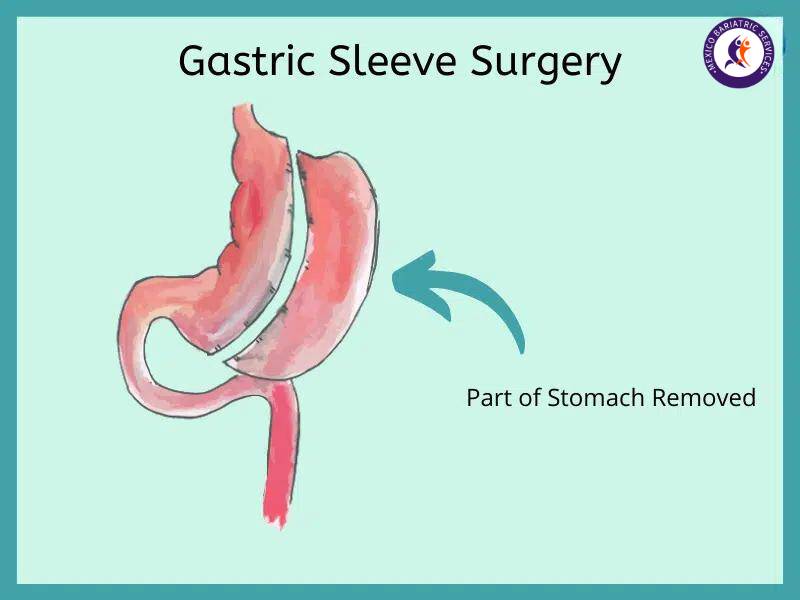Gastric Sleeve in Tijuana, Mexico: Healthy You @ Best Price
Start an affordable and healthy transformation with gastric sleeve in Tijuana, Mexico. Learn about the best surgeons, an all-inclusive package, and why it can be the perfect choice for you. Keep reading for more details.
Gastric sleeve cost without insurance is sky-high in the US.
High costs drive Americans and Canadians to seek affordable weight loss surgery in Mexico.
Regarding Tijuana, it’s not just the cost but quality care, too! Check out the patient reviews to learn more.
Gastric Sleeve Surgery in Tijuana, Mexico Reviews
Mexico Bariatric Services has assisted hundreds in achieving success with sleeve gastrectomy. Read some of the reviews below:
You can also watch testimonials from Kelly and Sandra about their gastric sleeve surgery experiences in Tijuana.
Gastric Sleeve in Tijuana, Mexico Transformations: Before and After Pictures
Explore real before and after photos of gastric sleeve surgeries in Tijuana.
Witness Nicole Parker’s incredible 136-pound weight loss and Janelle Woodburn’s impressive 90-pound transformation in just 17 months.


Wondering if these jaw-dropping results would burn a hole in your pocket?
Check out the cost section below to learn about Tijuana gastric sleeve costs.
How Much Does a Gastric Sleeve Cost in Tijuana, Mexico?
In Tijuana, Mexico, the cost of gastric sleeve surgery is $4,395. Moreover, it covers a 2-night hospital stay, 1 hotel night, airport transfers, and medical expenses.
Therefore, you save over 60% compared to the $11,000 cost in the US and Canada.
Gastric sleeve in Tijuana vs US/Canada
| Procedure | Tijuana | US/Canada |
|---|---|---|
| Gastric Sleeve Surgery | $4,395 | $11,000 |
| *Prices are case dependent | ||
Note that there are extra charges for BMI > 50. Check out the table below:
| BMI | Charges |
|---|---|
| 50-59 | $750 |
| 60-69 | $1,250 |
| 70-79 | $1,750 |
*Prices are case-dependent
You can pay for gastric sleeve in Tijuana, Mexico using:
Besides, you can avail financing with SuperMoney.
If you are concerned about the gastric sleeve cost with insurance, note that it depends on:
- Your health insurance policy
- The hospital or surgeon you choose
Cost Savings for Gastric Sleeve in Tijuana, Mexico
It is evident from the cost table that choosing Tijuana for your gastric sleeve offers substantial savings!
You can save between 60-65% on treatment while getting treated by the top Tijuana bariatric surgeons.
Here, you can get the cheapest gastric sleeve surgery in Mexico without compromising quality.
Take a step forward!
Check out these places as potential choices!
Why Is Gastric Sleeve Surgery Cheaper in Tijuana, Mexico?
The low prices of Tijuana gastric sleeve are primarily due to Mexico’s low cost of living.
The Mexican cost of living is 86% cheaper than in the US.1 This means lower medical expenses and staff wages.
Unlike in high-cost countries like the US, these don’t add extra burden to surgery costs in Mexico.
Gastric sleeve surgery in Tijuana, Mexico, is worth the travel and cost!
Don’t worry if you are not eligible for Tijuana gastric sleeve. Tijuana, Mexico, offers other effective weight loss options, too.
Here is a list of other Tijuana, Mexico bariatric surgery alternatives:
- Tijuana gastric bypass
- Tijuana gastric plication
- Mini gastric bypass
- Duodenal switch
You can also explore other options of gastric sleeve in Mexico.
Gastric Sleeve Mexico Tijuana: What Sets It Apart?
Here are the compelling reasons that make Tijuana, Mexico, an ultimate choice for gastric sleeve.
- Cost savings | You will save upto 60% on treatment compared to the US costs.
- Experienced surgeons | treatment by skilled surgeons who performed over 3000 surgeries.
- Proximity | Americans can conveniently reach Tijuana.
- Pre and post-surgical support | Free nutritionist consultation.
- English-speaking staff | No communication hassles.
In addition, there is a range of amenities included in prices.
What Is Covered in Gastric Sleeve Tijuana Cost?
Here we are at the best part of Tijuana gastric sleeve. All-inclusive gastric sleeve surgery packages in Tijuana!
Gastric sleeve Tijuana Mexico all-inclusive prices include:
- Pre and post-op tests
- Airport pick-up and drop-off
- Hospital and surgeon charges
- Hital hernia repair (if needed)*
- Medications (Hospital stay & at-home care)
- Ground transportation to and from the hospital and hotel
- Hotel stay for one night before surgery (Patient & one guest)
- Consultation with a certified nutritionist for pre and post-op diet
*Depends on the chosen surgeon and hospital
Note that the Gastric sleeve Tijuana cost does not include:
- Airfare
- Guest meals
- High BMI fee
- Local sightseeing
- Medicines like omeprazole and drugs for conditions like asthma or blood pressure
Choosing the right place for bariatric surgery can be a stressful task.
We provide some basic details to help you choose the best place to get gastric sleeve in Tijuana Mexico.
Tips To Choose a Reputable Bariatric Surgeon in Tijuana
While choosing the bariatric surgeon for your gastric sleeve in Tijuana, Mexico:
- Check the surgeon’s credentials, certifications, and experience.
- Know their success rates in performing gastric sleeve surgeries.
- Ensure the surgery center is accredited and has a positive reputation.
- Verify the use of modern technology for surgeries.
- Ask for before-and-after pictures. This helps to assess the surgeon’s skill and the potential outcomes visually.
- Read patient reviews to gain insights into the overall experience.
- Positive feedback builds confidence, and any concerns should be taken seriously.
- Keep an eye on hygiene standards at the clinic to minimize infection risks and ensure safety.
At MBS, we ensure a seamless experience through meticulous verification before partnering.
Learn about the best gastric sleeve surgeons in Tijuana, Mexico, by simply scrolling down.
Certified Surgeons for Gastric Sleeve in Tijuana, Mexico
Here are the finest surgeons for your gastric sleeve in Tijuana, Mexico.

Dr. JP Fernandez
Experience weight loss excellence with Tijuana’s leading surgeons. Your personalized journey begins now.
Step forward for a healthier future!
In-Depth Insights on Gastric Sleeve in Tijuana, Mexico
Gastric sleeve or sleeve gastrectomy is a non-reversible surgery. A large portion of the stomach is removed.2
This leaves behind a tube-like structure with a much smaller capacity.
The reduced size of the stomach greatly reduces the amount of food an individual can consume. This gradually brings about the desired weight loss.
Having gastric sleeve surgery has the following benefits: 3
- Change in appetite
- Improvement in diabetes
- Improved sleep quality by affecting sleep apnea
How Does Gastric Sleeve Surgery Work?
Sleeve gastrectomy alters the stomach size greatly. But it’s not just about changing the stomach size and how your intestines absorb.
Further, gastric sleeve surgery impacts satiety by altering the intestinal microbes.
And the outcome is feeling less hungry and fuller even with smaller meals.4
A unique effect of gastric sleeve is the reduced production of the hunger-inducing hormone called ghrelin.
This has a great effect on weight loss by reducing appetite.5

To get the gastric sleeve, you’ll need to meet certain qualifications.
By scrolling down, learn if the gastric sleeve is the right choice for your weight loss goals.
Is Gastric Sleeve Surgery for Me?
Gastric sleeve is usually considered when diet and exercise haven’t led to enough weight loss.
However, your weight loss surgeon will decide your eligibility before proceeding further.
Note that BMI is a crucial factor in deciding your eligibility. The minimum BMI for gastric sleeve surgery is 40.
However, you will be a suitable candidate if your BMI is 35 and you are suffering from diabetes or hypertension.
In addition, your surgeon will confirm if you:6
- Are older than 18 years of age
- Are not suffering from psychological problems
- Do not have intestinal issues like gastroesophageal reflux
It is not advisable to undergo gastric sleeve surgery in Tijuana, Mexico for high-risk patients.
Remember that selecting the right candidate is the key to gastric sleeve success.
Bariatric procedures indeed make some major changes in the gastrointestinal tract. Hence, the selection of the right candidate is essential!
For an easier understanding, consider a pregnant woman for a gastric sleeve.
Is Pregnancy Safe for a Gastric Sleeve?
Gastric sleeve surgery is not advised for a pregnant woman because:7
- It affects the intestinal absorption of micronutrients like iron and folate
- This further leads to anemia and neural tube defects in growing babies.
Now, let’s look at how the gastric sleeve surgery process goes!
Pre-Op Preparation
If you qualify for surgery, you must pick a suitable date and make travel arrangements for Tijuana.
You will have to follow the liver-shrinking pre-bariatric diet for a few days to reduce the size of the liver.
This will make it easy for the surgeons to carry out the procedure.
Once you arrive in Tijuana, you will have to undergo a series of pre-operative tests before your surgery.
You will undergo the following pre-op tests for your surgery.
- Blood sugar levels
- Liver function tests
- Heart function tests like ECG
- Kidney function tests, including electrolyte urea and creatinine
What Happens During Gastric Sleeve Surgery?
The gastric sleeve surgery will be performed under anesthesia and will take around 1-2 hours.
Surgical Steps of the Gastric Sleeve:
- 3-5 tiny incisions will be made in the abdominal wall of the stomach.
- High-precision surgical instruments called trocars will be inserted through these incisions.
- Further, the blood vessels on the lateral side of the stomach will be divided.
- The insertion of a bougie into the stomach will follow this.
- Bougie is a measuring device that resembles a tube.
- It guides the surgeon in creating a sleeve by creating a bulge in the stomach.
- The surgeon will begin stapling the stomach from the pylorus.
- It results in the division of the stomach.
- The excised bigger portion is almost 75-80% of the original stomach.
- This portion will then be decompressed and removed from one of the incisions.
- After removing the instruments, the incisions will be closed.
- Your new stapled, banana-shaped stomach will have a gastric volume of just a quarter of the original.

Now, let’s move forward to learn about life after gastric sleeve surgery.
What To Expect Immediately After Gastric Sleeve Surgery?
You will have to undergo certain tests a day after the gastric sleeve. It is to rule out leaks from the gastric sleeve and establish the suture integrity.
Post-operative gastric sleeve tests:
- Bubble test
- Radiography test
- Barium swallow test
- High-pressure methylene blue leak test (HPMB)
Gastric Sleeve Surgical Recovery and Returning to Work
You will spend a couple of nights at the hospital. After an additional night in the hotel, you can fly home.
During this hospital stay, your condition will be monitored.
After discharge, allow your body sufficient rest to recover from the recent major change.
Follow the below tips for a smoother recovery after gastric sleeve in Tijuana, Mexico:
- Limit yourself to minimal physical activity during the first few weeks.
- However, do not restrain yourself from moving, as this can lead to blood clots.
- You may slowly resume work 2 weeks after gastric sleeve. This is relevant to simple desk jobs.
- Remember that strenuous exercises and lifting weights can put pressure on the abdomen. Hence, avoid them for a brief period.
We summarised the timeline for an easier understanding.
Gastric Sleeve Treatment Timeline
Day 1
- Travel to San Diego, CA
- Pick-up to Tijuana
- Hotel Stay
Day 2
- Shuttle to hospital
- Pre-op tests and consultation
- Undergo Surgery
Day 3
- Leak tests
- Liquid tests
- Post-op diet consultation
Day 4
- Pick up from the hospital
- Drive to San Diego, CA
- Return to home/hotel
| Day 1 | Day 2 | Day 3 | Day 4 |
|---|---|---|---|
| 1. Travel to San Diego, CA. 2. Pick-up to Tijuana 3. Hotel Stay | 1. Shuttle to hospital 2. Pre-op tests and consultation 3. Undergo Surgery | 1. Leak tests. 2. Liquid tests 3. Post-op diet consultation | 1. Pick up from the hospital 2. Drive to San Diego, CA 3. Return home/ hotel |
If surgery pain is your concern, the following section might be your help!
Is Gastric Sleeve in Tijuana, Mexico, Painful?
You will not feel the pain during gastric sleeve surgery as it will be done under anesthesia.
However, you may feel slight pain and discomfort around the incision sites as the anesthesia wears off.
Note that the gastric sleeve surgery in Tijuana, Mexico, is minimally invasive.
This means faster recovery, less pain, and smoother healing.
Gastric Sleeve: Expect the Unexpected!
Temporary hair loss is a common side effect of gastric sleeve.8
It usually occurs 12-16 weeks through surgery. This happens due to decreased protein uptake.
To help this, take multivitamins regularly.
Bariatric surgeries cause telogen effluvium, which causes the hair roots to go into a temporary resting state.
Since there is no damage to the follicle, hair eventually grows back.
Curious to know about weight loss? We’ve got you covered.
When To Expect Weight Loss After a Tijuana Gastric Sleeve?
After gastric sleeve surgery, you can expect significant weight loss during the first year.
Expect a gradual, not rapid, progression in your weight loss journey for overall well-being.
Expected Weight Loss After Gastric Sleeve
| Time after gastric sleeve (months) | Expected weight loss |
|---|---|
| 1-3 | 30% |
| 4-6 | Visible weight loss results |
| 6-12 | 50% |
| 12-24 | 77% |
#Note that weight loss results may vary. We do not guarantee any specific results.
The actual weight loss varies from patient to patient as it depends on the individual:
- Health before the surgery
- Ability to comply with the suggested guidelines post-surgery
It is essential to follow some long-term care to ensure effective and lasting results.
Tips for Post-Gastric Sleeve Well-Being: Long-Term Basis
A gastric sleeve leaves your stomach in a banana-shaped pouch, restricting the size of the portion.
You will have to:
- Change your lifestyle after gastric sleeve slightly
- Keep an eye on your eating habits after your gastric sleeve surgery
Following the stage-wise gastric sleeve post-op diet is highly recommended for successful outcomes.
Concerned about the potential dangers of gastric sleeve? We’ve it covered for you.
Tijuana Gastric Sleeve Complications
Like any other surgery, sleeve gastrectomy has its share of risks and complications.
Here we listed the possible complications after gastric sleeve:9
- Vomiting
- Chronic nausea
- Acid reflux/GERD
- Dilated esophagus
- Obstruction in the stomach
- Risks related to anesthesia
- Problems with eating certain foods
- Inadequate weight loss and weight regain
However, effective weight loss and improved health are possible with an experienced surgeon for gastric sleeve.
Gastric Sleeve in Mexico Horror Stories
Medical treatments can fail in unsafe environments or with non-professionals.
The success and safety of gastric sleeve surgery depend on choosing the right surgeon and clinic.
Further, the surgeon’s selection of the right candidate matters, too.
A BMI of at least 40 is mandatory. Choosing the wrong surgeon or clinic can lead to complications.
Hence, it is always advised to research thoroughly.
When it comes to the safety of the treatment, the upcoming section can be of help!
You will understand what makes gastric sleeve the safest bariatric surgery in Tijuana, Mexico.
Is It Safe To Choose Tijuana for Gastric Sleeve Surgery?
Getting a gastric sleeve in Tijuana, Mexico, is safe when you choose the right surgeon and clinic.
We at MBS are associated with well-experienced and certified bariatric surgeons.
Some of them have upto 37 years of experience. Further, they have a track record of performing over 3000+ bariatric procedures.
Moreover, MBS-associated surgeons are renowned for having a 0% complication rate.
Is Tijuana safe to have weight loss surgery? Are you one who has this concern?
Note that not all places in Mexico are equally dangerous. Being a medical traveler, following the basic safety tips in Tijuana will help.10
Here’s some additional information you should be aware of.
How To Get There?
Reaching Tijuana would be a breeze. You can fly directly to Tijuana or the San Diego International Airport and take the road to Tijuana.
From the airport, you can avail a free pick-up.
Border Crossing
From the United States, you will have to cross the San Ysidro Port of Entry in San Diego to enter Tijuana.
The port of entry is open 24*7. However, we advise you to check the border wait times beforehand.
Hotel Stay
Free hotel stays for one night are included in all MBS Gastric Sleeve packages in Tijuana, Mexico.
You may have one guest to assist you during the procedure.
Medical Tourism in Tijuana, Mexico
You can make your gastric sleeve journey a refreshing experience by sightseeing in Tijuana, Mexico.
Discover Tijuana, a fantastic tourist spot. Be sure to explore the Playas del Tijuana, Plaza Santa Cecilia, and Tijuana Arch.



Enjoy the amazing flavors of Mexico. Try classics like tacos, Conchas, and Albondigas for a delicious experience!



Now, let’s tackle your questions. Check out some of the FAQs.
FAQs
Conclusion
Explore cost-effective gastric sleeve surgery in Tijuana, Mexico.
Benefit from an all-inclusive package for a healthier future. Your transformation awaits!
Start your transformation today!
References
- Expatistan: Cost of living in the United States compared to Mexico
- NCBI: The advantages and disadvantages of sleeve gastrectomy; clinical laboratory to bedside review
- NCBI: The advantages and disadvantages of sleeve gastrectomy; clinical laboratory to bedside review
- NCBI: The advantages and disadvantages of sleeve gastrectomy; clinical laboratory to bedside review
- NCBI: Role of Hunger Hormone “Ghrelin” in Long-Term Weight Loss Following Laparoscopic Sleeve Gastrectomy
- NCBI: Sleeve Gastrectomy
- NCBI: Bariatric surgery and its impact on fertility, pregnancy and its outcome: A narrative review
- NCBI: Hair Loss After Metabolic and Bariatric Surgery: a Systematic Review and Meta-analysis
- Travel Safe Abroad: How Safe Is Tijuana for Travel?
- NCBI: Complications associated with laparoscopic sleeve gastrectomy – a review





